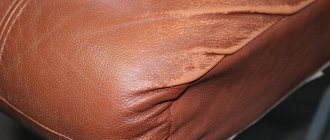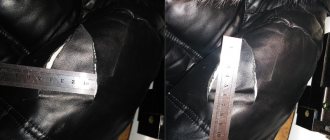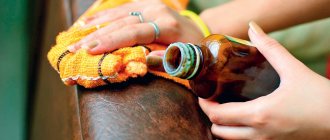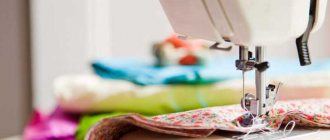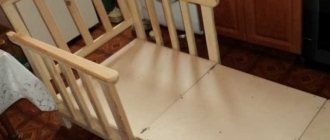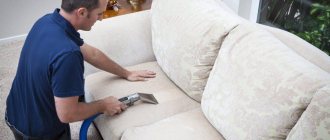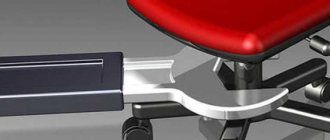What is liquid skin
Liquid leather is a polymer mixture based on two elements:
- water;
- alcohol.
These are the main components, but in addition to them, rubber resin and a sticky adhesive base are also used. These components allow the prepared mixture, upon contact with a leather product or leatherette furniture, to adhere as tightly as possible and form a fairly elastic consistency.
After liquid leather for furniture has hardened, it is almost impossible to distinguish it from the material, since the mixture perfectly adapts to the characteristics of the leather, and taking into account the fact that the characteristics are as identical as possible not only from the visual side, but also in technical parameters, it can be called liquid skin is an ideal way to solve such issues.
The photo shows an example of how you can update leather furniture.
In addition to all the above components, dye is also used to make this adhesive mixture. It is necessary in order to create different shades and be able to repair all products. Thanks to this component, a full range of liquid leather mixtures are available on the market.
Almost every happy owner of a leather sofa has faced the need for periodic restoration.
And if the furniture has some unusual shade that is not on sale, then you can mix several options to obtain the desired effect. These products are used in many places, but its main direction is the restoration of leather goods. However, this material is also great for:
- dermantine;
- artificial leather;
- vinyl.
Not all damage to the skin can be repaired.
The specificity of liquid leather is such that only minor damage can be repaired. Large abrasions cannot be hidden with such material.
Repair methods
Simple solutions will help you quickly repair a leather seat or eliminate a defect in another part of a leather interior. The restoration method depends on the problem. Inspect the upholstery in your car and look for any imperfections.
Common problems with leather salon drapery:
- tear along the seam. Seat upholstery that is torn at the seam is sewn up from the inside out. The casing is removed, turned inside out, and torn threads are removed. The connections of the parts are manually sewn with double thread to match the cover, simulating machine stitching, or sewn on a machine;
- abrasions. Abrasion of leather upholstery appears in the third year of intensive use. The solution is to paint it in the same tone or repaint it. Use liquid leather or paint. The processed fragment is degreased, painted, and dried. For restoration, they practice repainting a segment or completely painting the seats and interior. A small defect is covered by spraying aerosol paint;
- Scratches can be removed by filling the leather upholstery with a metal marker. The product fills a microscopic crack and smoothes the surface. Before applying the composition, the surface is degreased;
- holes as a result of careless use in the form of tears, cuts or burns are patched with patches. As a patch, they use leather reserves, cut off a fragment from under the seats, and use leatherette in the same color. The seat cover or upholstery is removed, turned inside out, and the uneven edges are cut off. A larger flap is prepared and glued to the defect area. You can seal the skin from the outside, having previously degreased the surface;
- deep damage is filled with liquid skin. Polymer-based products are selected according to texture and color. The surface of the interior upholstery or seat is degreased, filled with the composition, and dried.
Important! Liquid leather repairs are carried out with preliminary testing. The selected product is dripped onto a piece of upholstery in a closed segment and wait for the polymer to harden. If the color and texture do not differ from the restored finish, restoration is carried out.
Simple methods of repairing a car leather interior will allow the drapery to return freshness, presentability, and cleanliness.
Selection of materials and devices
Before restoring leather upholstery, a material is selected that will match the interior drapery in color and texture. Before restoration, instruments are prepared. The list of devices depends on the repair method and the defect.
A standard car leather repair kit includes:
- liquid skin;
- small scissors;
- tweezers;
- container for preparing a restorative polymer composition;
- dry powder glue;
- leather paint;
- fine mesh or plastic for placing under the patch;
- degreaser;
- sandpaper grit 800-2000.
To dry the glue or paint, use a household hair dryer or iron. When ironing the restored segment, several layers of paper or folded newspaper are laid between the hot sole and the upholstery.
Preparatory work
Before repairing leather at a car dealership, prepare materials and equipment within walking distance. Carry out restoration in a warm room or on a summer day without precipitation.
Prepare your work area:
- dismantle the chairs to gain access to the covers and lower surfaces;
- remove the covers;
- shake out the covers, turn them out if necessary;
As a degreaser, use a solution of water and dishwashing gel (50 ml of product per 1 liter of liquid), acetone, white spirit, isopropyl alcohol, cologne or hydrogen peroxide.
Restoring the surface by gluing a patch
Carry out your own restoration of leather covers or car upholstery in compliance with the following algorithm:
- place the defective product in a well-lit place;
- clean the restoration fragment from dirt;
- degrease the recovery segment;
- prepare the defect for repair by cutting off lining threads, scraps of leather, and burnt edges;
- sand the segment with sandpaper;
- remove dust;
- attach a piece of reinforced fine-mesh plastic mesh larger than the hole. The edges of the patch should protrude 1.5 cm beyond the hole. The patch should cover the defect;
- glue a piece of leather or leatherette onto a special glue;
- Press the edges of the surfaces to be glued tightly.
Dry the gluing area with a hairdryer or iron it.
Liquid leather repair
When painting leather, degrease the segment at the stage of gluing the reinforcing mesh. Prepare the ingredients for making paint. Follow the step-by-step algorithm:
- lay the casing or restored fragment on a flat surface;
- Pour thermal powder with a small spatula or stick;
- distribute the ingredient evenly over the mesh surface;
- heat the restoration site with a hairdryer or iron through the paper. A polymer-based powder substance, sweat is thermally melted, filling the pores of the mesh;
- remove possible irregularities and excess material;
- Apply liquid leather, color the segment evenly.
Interesting! Most products, including leather upholstery, use cow leather.
If the skin is thick and the defect is deep, do several stains.
Textured repair
You can carry out complex repairs by recreating the texture using the “Mold maker” product. This is polymer clay, with which you can recreate a textured surface and repeat the design. The method is used in the restoration of reptile skin and leather products made from reptiles.
Step-by-step instruction:
- apply the product to glass or plastic containers;
- use a wooden spatula or spatula to mix the substance until smooth;
- attach an imprint on top in the form of a piece of leather with the same pattern, press it down;
- after 1.5 hours, remove the oppression;
- cut out a patch of the required size from the resulting blank that imitates leather;
- Apply the gel with a brush to the damaged prepared fragment with the reinforcement mesh glued;
- glue a fragment of polymer clay;
- dry the location with a hairdryer or iron it through paper;
- Paint the patch in the desired shade with leather paint.
The two-component Mold maker requires patience and precision. Work in good light.
Sealing the slot
Smooth cuts in leather upholstery are restored by sewing up the edges with a neat seam across the edge or by attaching a reinforcing mesh from the inside. The fragment is degreased with white spirit or isopropyl alcohol. A mesh plastic material is glued to the damaged area, tightly connecting the cut area.
After gluing the base from the wrong side, the defect becomes a deep scratch. The gap is filled with liquid skin. The repaired area is painted to match the upholstery of the car interior.
How to choose
If there is a need to disguise small scratches or abrasions on furniture made from the above materials, then the choice of liquid leather should be approached only according to the color parameter. Since the quality characteristics, as well as the composition of the liquid, are almost identical for products of different brands.
Choose high-quality leather restoration products.
If you have a problem choosing a shade, and the desired option is not on sale, you can also get out of the situation in the following way. If, for example, the sofa is made in dark brown, and among the product range there are only brown and black options, then you can purchase two bottles and mix them to the desired shade. The mixture allows you to perform similar manipulations.
The cream will help you take care of your skin.
In addition, this will not qualitatively affect the quality of the product repair. Today, of all the brands that produce liquid leather for furniture repair, the most popular brands are the following:
- Liquid leather is a Russian manufacturer. The mixture dries completely and the furniture will be ready for use after 2-8 hours of rest. Drying time depends on the thickness of the applied layer. The color palette is not large enough.
- Saphir is a product from France. The product dries quite quickly. The product will be ready for use within 24 hours, but it can be done earlier, it all depends on the thickness of the applied layer. The price of products of this brand is somewhat high.
- Bradex - Israeli production. After application, the product will be ready in eight to twelve hours. In each case individually, depending on the amount of liquid applied. However, it is worth noting that the color palette leaves much to be desired.
Separate care is suitable for each skin type.
In any case, you can always familiarize yourself with the proposed color options and the cost of the product, and then choose the most suitable option for yourself.
Repairing holes and cracks
Repairing holes in furniture will require a patch and crack filler. The restoration of a leather sofa in this case looks like this:
- Clean the surface with rubbing alcohol;
- Apply special glue for leather products or superglue to the damaged area from the inside using a toothpick;
- Gently press down on the hook and straighten it out. Quickly wipe off excess glue with a cloth or napkin;
- Use sandpaper to sand the gluing area. It should become soft to the touch. This item is only necessary if superglue is used;
- If the skin color becomes different, paint the area and apply a topcoat.
Eliminate cracks using liquid leather. It is a coloring and adhesive plastic substance. The set contains 7 colors of liquid leather. To select the desired shade, mix several colors.
Before use, the surface of the furniture is treated with alcohol to clean and degrease. Apply the product to the damaged areas with a brush and smooth it out. When everything is dry, repeat the steps again.
Treat with alcohol
Apply glue to the hole
We press down the holds
Painting the coating
Process with sandpaper
How to use liquid skin correctly
In order to eliminate scuffs on a leather product, you need to apply a liquid to the surface. This must be done carefully and slowly, making sure that the layer is even and not too thick. It is better to do this in several stages.
Gently apply liquid leather to furniture.
Initially, apply the first thin layer, wait for it to dry completely and then see if it is enough, or if you need to repeat the procedure. After the layer has been applied to the surface, you need to take a sponge and walk over the area and apply a little pressure. Such manipulations will help give the repaired area the relief that is inherent in natural fabric.
If you stain a leather sofa with something greasy, you can cover the stains with talcum powder for two hours.
In order to level the area, it is best to use a dry sponge. After this, you can let the product rest and at the same time dry the treated area. After complete drying occurs, it will be clear whether the procedure needs to be repeated or not.
Scuffs and small scratches on leather upholstery can simply be painted over.
If a sofa or other piece of furniture is damaged due to paresis, then liquid leather is applied as follows. Initially, the two edges of the cut are pulled together as tightly as possible and liquid is applied to the separation site. After it hardens, reapply the product and do the same procedures with the sponge as with normal rubbing.
Liquid skin is easier to apply with a sponge.
How to remove stains from coating?
A problem that many people face is dirty, greasy stains. How to restore leatherette after you dropped something on the sofa or fell on the street and stained your jacket?
Most grease stains won't stand up to regular detergent. Apply it to a sponge and thoroughly wipe the stained surface. You can wash it off immediately, but you can leave it on for a while.
If you cannot remove the stain, try gasoline or turpentine. Gently apply the substance to the gauze and then wipe the damaged material. After complete drying, the leather on your shoes, jacket or sofa will look as if nothing had happened to it.
Sofa repair
To the question: how to repair a leather sofa, the answer is quite simple. The procedure itself is quite simple, the main thing is to follow the instructions and recommendations for using the product. It is first necessary to clean the future repair site so that there are no excess fibers on it, which often remain after mechanical damage.
Use additional tools to restore furniture.
So that the liquid skin can grasp and fix the cut site as much as possible, it can be carefully washed in several places. This procedure allows you to make a smaller cut, more accurately divide it into smaller parts, and the product will be able to maximize its qualities. After this, you can safely carry out the degreasing procedure using detergent.
Colored leather is more difficult to restore.
After which you can choose the appropriate shade; if the desired shade is not in stock, you can mix several options using a table with colors. Then you can apply the prepared mixture. This is done using a small piece of foam rubber or a painting brush. The layer may be applied unevenly, and this is quite natural.
Scratches on a leather sofa can be partially eliminated or made as invisible as possible using special products.
But unevenness needs to be removed using a piece of plastic, a small spatula or a ruler. Then leave the area to dry completely, ensuring that it does not come into contact with anything.
Note! In order for the treated area to have the same relief texture as the entire sofa, it is necessary to apply a piece of the same material to the place of work for a few seconds, then remove it.
Most often you will get a good result.
Sometimes the result may not live up to expectations, and it seems that the entire restoration procedure using liquid skin was in vain, and the material does not meet the declared qualities. But most often the reasons may be:
- The cut is too large to be repaired or masked with a similar product, and another method of restoration must be used.
- Incorrectly selected shade, after which the treatment area is visible to the naked eye.
- Failure to comply with the rules of use, failure to follow the sequence of repair operations.
- Incorrectly selected piece of leather for applying a visual pattern.
Take good care of your furniture!
Therefore, it is so important to follow all recommendations from the product manufacturer in order to restore artificial leather on the sofa.
How to avoid damaging a genuine leather jacket during repairs
There are several ways to repair a leatherette product. Aerosol paints and shoe polishes help disguise shallow scratches and minor abrasions.
When starting to renew the material, prepare fabric paint in cans, warm water, a foam sponge, dishwashing detergent and orange peel.
The leather jacket is usually fastened with a zipper or buttons. Modern products are made of soft natural or artificial leather with or without insulated lining. The skin of different animals is used for sewing - buffalo, pigs, cows, sheep, horses, goats, etc.
Buffalo leather is very durable and elastic, so jackets made from it can be worn for years without any problems.
Pigskin is the cheapest because it has poor technical characteristics. It is porous and inelastic, so even new jackets often develop defects.
The most problematic areas of leather jackets:
- collar;
- sleeves;
- cuffs;
- pocket area;
- shoulder and side seams.
If your leather jacket is torn, repairs should begin immediately. When a gap or cut forms along a seam, the hole quickly increases in size. This especially applies to places where the skin stretches the most - the area of pockets, elbows, chest.
How to mend a gap
Tearing of the material at an angle is a problem that owners of leather jackets often encounter. If you get caught on a sharp metal object, defects will certainly appear on your skin:
- break in the shape of an angle;
- a hole due to a completely torn flap of skin.
The methods for repairing a jacket in both cases are radically different. When the skin is torn at an angle, restoration is less labor-intensive and takes little time.
How to sew a leather jacket when the material is torn at an angle:
- the jacket is turned inside out;
- in the area of the defect, the lining is ripped out along the seam;
- from the inside, the area of the rupture is degreased with alcohol;
- cut out a patch from a piece of fabric or leather so that it overlaps the edge of the tear by at least 1 cm;
- the patch is smeared with glue and applied to the area of the tear, having previously joined the edges of the torn material;
- a load is placed on top (a stack of books, a heavy iron, a decanter) and left for half an hour;
- If the patch has stuck well, the lining is sewn up.
To close the gap and not redo the work, you can’t rush. If you apply too much glue, smudges appear on the front of the jacket. Sometimes the edges of the torn flap diverge, causing the defect to become noticeable. To fix the problem you need to:
- bend the skin at the site of the tear;
- Using a toothpick, coat the edges with glue;
- place the jacket on a flat surface;
- move the edges of the tear by pressing them with your fingers;
- place the weight on top for 15-20 minutes.
To better camouflage the repaired area, it is treated with cream paint. If the jacket is winter, you can go outside in it only a day after restoration.
When a piece of skin is torn out, it is more difficult to deal with the hole. To revive the jacket, a double patch is made - from the inside and from the front side.
How to repair a leather jacket if the hole is not along the seam:
- the leather jacket is turned inside out, and the lining in the place of the hole is ripped open;
- the inside of the skin is degreased with alcohol;
- glue is applied to the patch and applied to the hole;
- place a load on top for 30-40 minutes;
- on the front side, glue a torn flap or a piece of skin as similar as possible to it, corresponding to the shape of the hole;
- the joint between the base material and the patch is carefully filled with glue;
- Once dry, cream is applied to the repaired area and the lining is sutured.
We suggest you read: How to bleach a white jacket
If a piece of leather is torn out in a visible place, the damaged area can be decorated with leather stripes or chevrons. In extreme cases, the patch is masked with a decorative seam.
If there is a cut, you can repair a leather jacket with your own hands using glue and a patch, tape, plaster or adhesive-based tape. If a hole appears on a sleeve or chest, it is recommended to use patches or keeper tape, as they are highly durable.
How to fix a hole in a leather jacket:
- in the area of the cut, the lining is peeled off;
- a rectangular patch is cut out of leather or thick fabric;
- the reverse side of the cut is degreased with gasoline or acetone;
- Moment glue is applied to the cut;
- a thin layer of glue is also applied to the cut-out patch;
- the scrap is glued to the cut so that it overlaps the edges by 1 cm;
- pressed down with a load from above;
- a day later, the results of the work are evaluated.
To disguise cuts, craftsmen use liquid leather - a means for repairing leather products, which in consistency does not differ from shoe glue. After polymerization, it turns into an elastic material. For the restoration of leather bags and jackets, the following is used:
- Guin – eliminates cuts, deep scratches, burns on the skin. The manufacturer produces adhesives in different colors - red, green, black, white, yellow, etc.
- Premium – restores burnt areas, cracks, abrasions and cuts. Professional glue has waterproof and frost-resistant properties.
- Kolorstar - masks deep scratches, small holes, abrasions and faded areas of leather. After drying, the glue becomes flexible and elastic, which prevents the glued edges of the product from coming apart.
To seal cuts with liquid leather you will need:
- bandage or piece of gauze;
- plastic card (bank, discount);
- tube of liquid skin.
Features of repair using liquid leather:
- a piece is cut out of gauze to cover the cut on the jacket;
- liquid skin is applied to the defect on the front side;
- a piece of gauze is placed on top, the edges of which are stretched;
- after 10 minutes, another layer of liquid skin is applied to the gauze;
- After 3 hours the glue dries completely.
Gauze or bandage plays the role of a reinforcing layer that prevents the edges of the cut from re-diverging. If desired, it is made from the wrong side, but glued with rubber glue. And from the face, a thin layer of liquid skin is applied to the cut only once.
A torn “wound” is the worst thing that can happen to a leather jacket. But if desired, it can be restored using leather or a patch.
Fixing a hole in a jacket:
- the product is turned inside out and the lining is ripped open in the area of the defect;
- use scissors to straighten the edges of the hole so that it takes on an oval or round shape;
- a patch is cut out of a piece of leather to the size of the hole in the jacket;
- on the reverse side the material is degreased;
- a patch is made from fabric;
- a piece of fabric is coated with glue and applied to the hole;
- leave the jacket under the load for 2 hours;
- a leather patch is inserted on the front side;
- glue is carefully poured along the edge;
- press down with a weight and leave for at least 12 hours;
- the lining is sewn together, and the problem area is lubricated with cream.
The edges of the patch should overlap the hole by 1-2 cm. Otherwise, after a couple of months the product will have to be restored again.
Cuffs and collar are the most problematic areas of a leather jacket. Due to constant friction, abrasions appear on them, and sometimes the skin cracks. If there are pieces of material that match the color, it is better to replace the worn parts. If this is not possible, restoration will have to be resorted to.
Leather jacket repair:
- Greasy and worn. The collar is treated with gasoline and then allowed to dry. Apply paint with a sponge to remove scuff marks.
- Cracked skin. Peeling sections of material are cut off with scissors. The problem area is degreased with alcohol. Apply a thin layer of liquid skin. After 3-4 hours, another layer of glue is applied. You need to make sure that the liquid skin does not extend beyond the edges of the crack. To prevent sagging, remove excess product with a dry cloth.
We suggest you read: A frying pan burns - what to do to prevent food from burning, how to heat it?
Failure to comply with the repair technique causes new defects. To avoid them, you should:
- use only special adhesives;
- degrease the area being repaired;
- Make patches only from leather or thick textiles.
During repairs, it is strictly not recommended to use a hair dryer, hot iron or lighter. By trying to speed up the cure of the glue, you are more likely to burn the fabric.
Repairing leather jackets is a labor-intensive process that cannot be rushed. If you want to give things a second life, take the procedure responsibly. Those who are not confident in their own abilities should turn to professionals in the studio.
Repair of other furniture elements
Liquid leather can be used not only for repairing sofas or armchairs. You can use it to update:
- seat upholstery;
- shoes;
- bags;
- outerwear.
Any leather product can be updated.
The repair procedure is no different from that described using the example of a sofa. The most important thing in this matter is to choose the right shade and allow the product to dry completely after processing. If the item is used before drying, then the entire repair process has gone down the drain.
Repair and restoration methods
There are various ways to restore a leather sofa. Depending on the area and depth of damage, the leather can be repainted, replaced or repaired. It is best to restore furniture made from this material using special means.
Painting, color restoration and removal of scuffs
The most affordable do-it-yourself restoration of leather furniture is partial or complete painting of the coating. It allows you to cosmetically update furniture while the upholstery is not yet torn, or completely change its color. The paint must be intended for leather. Dyes can be mixed with each other to obtain the desired shade.
Before work, you need to carefully prepare the surface. It needs to be cleaned of dust and degreased with acetone. Then we restore the damage step by step:
- To make the paint go on more evenly, the coating is evenly moistened with water using a sprayer.
- We apply paint. The upholstery should be treated gradually, in small sections. Liquid paint is rubbed into the skin with a swab, rag or sponge. The aerosol is applied by holding the can at the same distance from the surface.
- It may be necessary to apply the paint several times (from 3 to 6) to obtain the desired result, allowing each layer to dry thoroughly for 1-2 hours. You can speed up drying with a household hairdryer.
- The upholstery is wiped with a dry cloth, removing excess dye after each layer.
- The last thing to apply is a protective layer. It can have a glossy or matte surface.
How to seal a leather sofa
Holes on a leather sofa can be sealed. This method is only suitable for eliminating small cuts and cracks, the edges of which are pulled together. You need to use glue designed for working with leather, preferably water-based.
The surface is first degreased, glue is applied with a toothpick or match and the edges of the damage are tightly compressed. Excess adhesive is immediately and carefully removed. The edges can first be tightened with synthetic thread, which is removed after the glue has dried. In this case, the restoration of the leather product is completed by polishing and painting the gluing area.
If you need to seal a large hole on the sofa, use patches. Restoring a leather sofa with a hole involves cutting and gluing a piece of leather larger than the damage to the back of the upholstery. The patch has a round shape.
Liquid skin
Minor repairs to leather furniture items are carried out using liquid leather. This is a polymer mixture with the addition of rubber resin based on alcohol and water. By adhering to the base, the substance acquires strength and elasticity and does not crack. Dye is added to the mixture.
The choice of colors is quite wide. Due to its composition, “liquid leather” is suitable for repairing artificial leather, but the result will be less reliable than with natural material.
Repair of leather sofas with “liquid leather” is carried out as follows:
- The area is degreased with an organic solvent.
- The edges of the damage are sanded until smooth.
- Fill the crack with the product and leave for 2 hours. Deep damage is filled in several stages.
- Sand irregularities on the aggregate with 800 grit wet sandpaper.
- The color is evened out using paint or shoe polish
If the damage is too deep, it is duplicated from the inside out by gluing a patch. Then filled with liquid skin. The protruding edges of the damage can be pre-glued or stitched, and only masked with liquid leather. Over time, the layer of product is updated.
Padding
If it is no longer possible to restore the surface of the leather, the upholstery is replaced partially or completely. For example, if only the upholstery and the seat are worn out on a chair, the backrest can be left unchanged.
In this case, it is important to soberly assess the condition of the skin. If the piece of furniture has peeled off in different places, the upholstery is changed completely, but this is somewhat more complicated. Reupholstering leather furniture is not an easy process. It allows you to update not only the furniture, but the entire interior if you choose a different color or style.
Major repairs of leather furniture begin with dismantling. The furniture is disassembled, the upholstery is removed from the base, the spring blocks are replaced, and the old upholstery is carefully ripped apart to obtain patterns. Replacement material must be taken in reserve. Allowances are left up to 10 cm.
The procedure is as follows:
- The foam rubber is cut to the size of the parts and attached to the frame using a stapler. By making cushions from foam rubber or synthetic padding, you can slightly modify the shape of the legs and back.
- We sew the upholstery parts into one product. To assemble leather parts, you will need a sewing machine capable of sewing leather and reinforced threads.
- We stretch the upholstery from the middle to the edges and secure it with a stapler from the wrong side. The material is pulled carefully, evenly distributing the folds in the corners. The upholstery should not be overtightened, otherwise it may burst.
Overlays
Restoration of leather furniture is also carried out using overlays. This method changes the appearance of the furniture, since the part is placed on the front side of the upholstery. The overlays can be the same color or successfully disguised with paint, or they can be an applique of leather of different colors.
If the furniture was recently purchased, most manufacturers can provide a sample of upholstery repair material upon request. If this is not possible, you must select the material yourself. The overlay can be sewn or glued. The threads leave traces, so an error during operation can worsen the appearance of the product.
Replacement of accessories
A major restoration of a sofa made of leatherette or genuine leather is accompanied by the replacement of fittings, which during operation are subject to chemical and physical attack, break, wear out, and lose their appearance. Springs, furniture supports, couplers, armrests, and decorative elements are replaced.
There is no point in repairing these components. It is easier to replace them with others, in most cases more reliable and cutting-edge.
Repairing a sofa is not complete without replacing the locks, the steel mechanism of which becomes loose over time, plays appear in it, and springs fly off. Since major repairs of furniture are carried out infrequently, it is better to update the locks, even if they can be repaired.
Drying liquid skin
In order for the liquid skin at the repair site to dry, you do not need to use any additional means or special heating elements. After treatment, it’s enough just to leave it for a certain time until it hardens completely.
Read the instructions before using liquid leather.
Drying times depend on the brand of liquid leather used, as well as on the thickness of the applied layer. Some manufacturers offer options that dry within 24 hours. Other brands have a longer drying time.
How to fix significant damage
If a person is faced with a sufficiently large or deep cut, then applying liquid skin alone will not be enough. On her own, she will not be able to hide a large cut and disguise it. In this case, additional materials are used, namely adhesive fabric.
With the help of modern technologies, you can carry out minor repairs to leather products right at home.
The product is first prepared for repair, and if the rupture or cut is located in a difficult-to-reach place, it may be necessary to disassemble the product to ensure comfort and the ability to carry out a high-quality procedure. After which that part undergoes processing and degreasing. An adhesive cloth is then applied to the inside of the cut. So that she can secure and fix the cut as much as possible, you need to go over it with a hot iron.
After this, the liquid is evenly distributed on the outer part; for maximum naturalness, you can press a piece of the same leather. This procedure will help provide the area where the liquid skin is applied with exactly the same texture as the entire object.
Liquid leather is a paint that seamlessly seals holes in the leather.
After the mixture has completely dried, control and inspection are carried out. If one layer is not enough, then you can repeat the procedure several times for complete masking.
Important! If there is no identical piece of leather, you can use a napkin. In this case, liquid leather is applied not to the product, but to a napkin, after which it is pressed into the desired place for a few seconds and then removed, and the product is left to dry.
How to replace a lock on a leather jacket
Repairing leather goods is actually quite simple. The lock on jackets often breaks. It is not always possible to repair it at home, since this requires special equipment. In addition, first you need to flog the old lock and then wedge in a new one. A regular sewing machine will not take leather. Therefore, you can simply sew a new lock on top of the old one. It's very quick and much easier than replacing.
Advantages and disadvantages of the product
The mixture, after its release on the market, quickly gained popularity and great demand. This is explained by a large number of advantages that are characteristic of it.
Any remedy has pros and cons.
Among the main advantages are the following:
- easy to apply to damaged areas;
- dries quickly;
- polymerization occurs after 20 minutes, which allows you to mix several colors to obtain the desired shade;
- durable and elastic;
- penetrates well into the surface, preventing subsequent delamination;
- not afraid of temperature changes;
- long service life;
- does not require additional thermal treatment methods;
- the composition does not contain substances that can adversely affect human health and the environment.
“Liquid skin” is very easily absorbed into the material.
Nothing is perfect, so even such a universal product as liquid skin has its drawbacks. These include the fact that only small areas can be treated and masked. No other disadvantages were found.
How to restore eco-leather on a sofa
Gloves, a purse, a business card holder that have lost their shine and color saturation are wiped with fresh orange peel. But keep in mind that the product will fade again in just a week. Grease stains are perfectly removed by dishwashing detergents. Drop a little product onto a damp sponge and wipe the contaminated area with it.
The gel can be washed off immediately or left for several hours. Gasoline or turpentine helps fight stubborn stains. Professional paints for artificial and natural leather perfectly renew the color. The coloring pigment literally penetrates into the structure of the fabric.
The main advantage of this method is the rich color palette: from neutral colors to acidic shades. Transparent varnish is used as the finishing layer. Aerosols paint over areas with peeling paint, fill small scratches and smooth out the surface. The product should be applied in the thinnest layer: a large amount of paint is the main reason for the formation of smudges and cracking of a freshly painted area.
Methods and materials
An alternative to aerosols and professional paints is liquid leather. The product contains an adhesive base, dyes and rubber resin.
Liquid leather creates a so-called leather relief on the surface. Ideal at first glance, the material has its drawbacks. For example, it is only suitable for filling scratches, cuts and punctures. It will not be possible to patch a large gap.
Difficulties also arise when choosing the right shade. Rare colors are obtained only by mixing primary tones. During work, you must strictly follow the instructions and not neglect the basic laws of color. It is unlikely that you will be able to choose an unusual color palette with a predominance of golden and silver shades.
Manufacturers offer only classic colors: black, white, red, green, blue, yellow, brown, gray. Liquid leather recreates both glossy and matte textures.
The main thing in restoring eco-leather is recreating the relief pattern. It is better to paint over a small area (no more than 1 cm2) with a brush. The surface is pre-degreased for better adhesion of the eco-leather to the polymer material. The place of puncture, cut, or scratch is cleaned of protruding fibers of fabric and glued with gauze from the inside.
Liquid leather is applied in two stages: first, a very thin first layer, then a second layer, applied after two to three hours. Restored eco-leather dries completely within 24 hours.
This method is only suitable for perfectly smooth surfaces. An ordinary napkin on which liquid leather is applied will help to recreate the relief. The napkin must be applied to the entire area with a clearly embossed pattern, and then dried for ten hours. This blank will serve as a template for creating natural irregularities.
We suggest you familiarize yourself with How to properly sew jeans on the sides, waist, hips, legs, and back seam at home? How to sew on your own and reduce large men's and women's jeans to a smaller size?
The napkin should be applied only after applying two layers. You can get an imprint using a piece of natural or artificial leather, which is cut from old shoes or gloves.
Leather furniture looks impressive and stylish. People are increasingly refusing to buy expensive sofas and armchairs upholstered in natural leather due to high costs and ethical principles. An inexpensive alternative has become eco-leather, which in appearance is practically no different from natural leather, and in some respects even surpasses it.
Liquid leather is rightfully considered the best material for the restoration and restoration of ecological leather. The polymer material fills cracks, cuts, marks from teeth and claws.
Restoration work is carried out in several stages:
- the surface is leveled, threads and fibers are removed;
- the edges of the cut or hole are carefully stitched or glued from the inside;
- eco-leather is wiped with liquid detergent and dried;
- the desired shade is selected by mixing several basic colors;
- liquid skin is applied with an art brush or foam rubber;
- The repaired sofa is left to dry for a day.
If abrasions and damage occupy a large area, then the furniture cannot be restored. It is also unlikely that a sofa upholstered in eco-leather in an exotic color (light green, turquoise, coral, terracotta, lilac) will be able to return to its original appearance. At home, it will not be possible to recreate a complex and ornate design using a napkin or a piece of old leather.
The leader among manufacturers of restoration pastes is the French company Saphir. Restoring cream extends the service life of damaged, worn and discolored products. The product is suitable for smooth surfaces; when applied, it creates a durable and elastic layer that repels water. Saphir does not stain clothes and dries quickly.
When working with liquid leather, you should wear plastic gloves. These gloves are used by hairdressers when coloring hair. Rubber products are not suitable.
Storage of liquid skin
If liquid skin is stored correctly, then such a tube can be used repeatedly and for a very long time. Moreover, the mixture does not change its characteristics and features for the worse.
Manufacturers recommend storing the tube with the adhesive mixture in places that are difficult for children to reach, and should not expose it to direct sunlight. The ideal storage temperature is zero degrees Celsius.
The result of using liquid skin.
If you follow all the recommendations regarding the storage of liquid leather, then it is quite safe and relevant to use it for two years.
Liquid leather applied to the area required for restoration can retain its characteristics for 35 years. At the same time, it does not change its qualities when the air temperature fluctuates in the following range: from -35 to +70.
